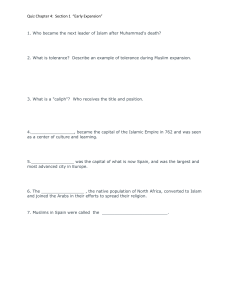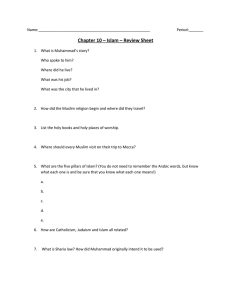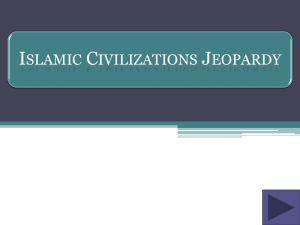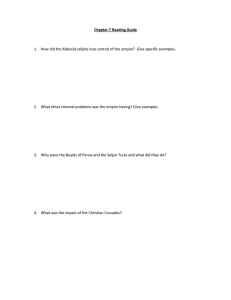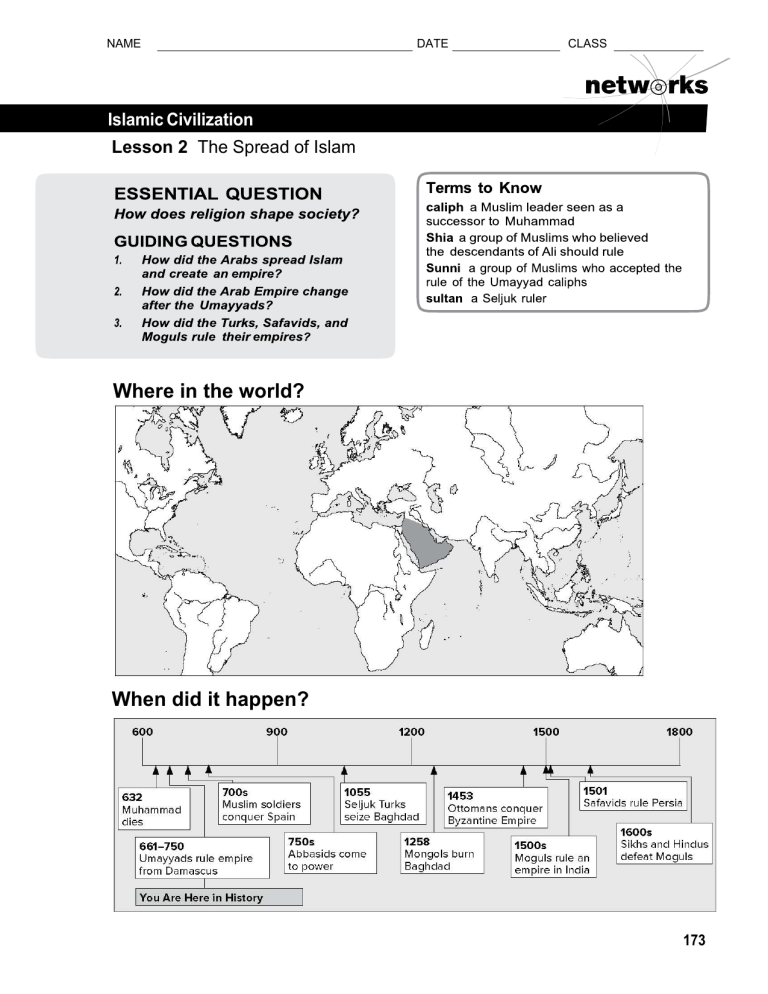
NAME DATE CLASS Islamic Civilization Lesson 2 The Spread of Islam Where in the world? When did it happen? 173 NAME DATE CLASS Islamic Civilization Lesson 2 The Spread of Islam, Continued Founding an Empire Muhammad died in 632. He left no directions about choosing the leader who should come after him. A group of Muslim leaders selected a new kind of leader. They called this leader the caliph, or the successor. The caliph was the successor to Muhammad. Glue Foldable here The first four caliphs were relatives or friends of Muhammad. Their goal was to protect and to spread Islam. Their armies conquered many lands beyond the Arabian peninsula. They conquered lands in Southwest Asia and Africa. After the first four caliphs, a new group of caliphs ruled. They were called the Umayyads. They ruled the empire from the city of Damascus in Syria. Their goal also was to spread Islam. Their armies expanded further into Asia and Africa. They also conquered Spain in Europe in the 700s. The Umayyads brought their religion, customs, and traditions to Spain. Spanish Muslims built centers of Islamic government and culture. Jewish, Christian, and Muslim scholars studied and worked together. The Muslims were good warriors and fought well in battle. They believed they had a duty to spread Islam. The people of other empires had sometimes been forced to follow the religion of their leaders. The Muslims let the people they conquered practice their own religions. Muslim merchants also spread Islamic faith and culture. The merchants built trading posts in the conquered lands, such as Southeast Asia. Today, in Southeast Asia, the country of Indonesia has more Muslims than any country in the world. Muslims spread Islam through conquest, trade, and teaching. 174 First Four Caliphs, the NAME DATE CLASS Islamic Civilization Lesson 2 The Spread of Islam, Continued Division and Growth There were groups in Islam that argued about who had the right to be caliph. Muslims divided into two groups over the issue. The Shia believed only people descended from Muhammad's son-inlaw, Ali, should be caliphs. The Sunni, a larger group than the Shia, disagreed. They did not think caliphs had to be related to Muhammad. Today the two groups are still divided over this question. They do both agree, however, on the basic beliefs of Islam. Around 750, the Shia Muslims rebelled and took over the rule from the Umayyad caliphs. The new caliphs were called Abbasids. The Abbasid caliphs focused on improving trade and culture. They built the city of Baghdad. It became the new capital of the Arab Empire. All the trade routes passed through Baghdad. It was a beautiful and wealthy city. 7. In 1055 Baghdad was seized by people called the Seljuk Turks. They came from central Asia and invaded the Arab Empire. The Seljuk Turks and Abbasids ruled together. The leader of the Turks was called a sultan. The sultan controlled the military and the government. The Abbasid caliphs managed religious matters. They ruled for 200 years this way. In 1258 people from central Asia, called Mongols,quickly moved into the empire. The Mongols burned Baghdad and killed thousands of people. The Arab Empire was over. 175 NAME DATE CLASS Islamic Civilization Lesson 2 The Spread of Islam, Continued Three Muslim Empires After the Arab Empire ended in 1258, other Muslim groups built their own empires. The Ottomans were based in what is now the country of Turkey. They built the largest Islamic empire. It lasted until the early 1900s. The Ottomans conquered much of the Byzantine Empire and expanded further into Europe, Southwest Asia, and North Africa. Rulers of the Ottoman Empire were also called sultans. The most famous Ottoman sultan was Suleiman I. He ruled during the 1500s. He was called the “Lawgiver” because he organized Ottoman laws. Suleiman also built schools and mosques throughout the empire. The Ottoman Empire was very large. Islam was the official religion of the empire. Muslims had special privileges. NonMuslims had to follow different laws. They had to pay a special tax to practice their own religion. Persia was one land the Ottomans could not conquer. It was ruled by the Safavids from the 1500s to the 1700s. The Savafids were Shia and bitter enemies of the Ottomans, who were Sunni. During the Safavid rule, Persian became the language of trade and culture. Today in Pakistan people speak Urdu. This language is partly based on Persian. 10. What is Urdu? The third Muslim empire was in India. In the 1500s, the Moguls conquered India. Under a Mogul emperor named Akbar, non- Muslims were treated fairly. Later Mogul rulers treated Hindus and Sikhs cruelly. The religion of Sikhism started in the 1500s. The Sikhs believe in one God and rely on one holy book called the Adigranth. Today, sikhism is the fifth largest religion in the world. 11. Place a three-tab Venn Groups in Islam. Write What 176
